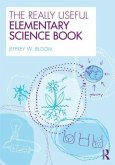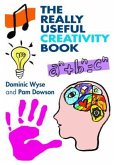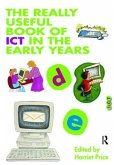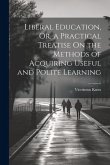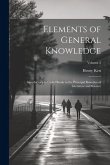Tracy-Ann Aston
The Really Useful Book of Science Experiments
100 easy ideas for primary school teachers
Tracy-Ann Aston
The Really Useful Book of Science Experiments
100 easy ideas for primary school teachers
- Broschiertes Buch
- Merkliste
- Auf die Merkliste
- Bewerten Bewerten
- Teilen
- Produkt teilen
- Produkterinnerung
- Produkterinnerung
The Really Useful Book of Science Experiments contains 100 simple-to-do science experiments that can be confidently carried out by any teacher in a primary school classroom with minimal (or no!) specialist equipment needed. The experiments in this book are broken down into easily manageable sections including: It's alive: experiments that explore our living world, including the human body, plants, ecology and disease A material world: experiments that explore the materials that make up our world and their properties, including metals, acids and alkalis, water and elements Let's get physical:…mehr
Andere Kunden interessierten sich auch für
![The Really Useful Elementary Science Book The Really Useful Elementary Science Book]() Jeffrey W. BloomThe Really Useful Elementary Science Book74,99 €
Jeffrey W. BloomThe Really Useful Elementary Science Book74,99 €![The Really Useful Creativity Book The Really Useful Creativity Book]() Dominic WyseThe Really Useful Creativity Book63,99 €
Dominic WyseThe Really Useful Creativity Book63,99 €![The Really Useful Book of ICT in the Early Years The Really Useful Book of ICT in the Early Years]() The Really Useful Book of ICT in the Early Years57,99 €
The Really Useful Book of ICT in the Early Years57,99 €![Liberal Education, Or, a Practical Treatise On the Methods of Acquiring Useful and Polite Learning Liberal Education, Or, a Practical Treatise On the Methods of Acquiring Useful and Polite Learning]() Vicesimus KnoxLiberal Education, Or, a Practical Treatise On the Methods of Acquiring Useful and Polite Learning25,99 €
Vicesimus KnoxLiberal Education, Or, a Practical Treatise On the Methods of Acquiring Useful and Polite Learning25,99 €![Elements of General Knowledge: Introductory to Useful Books in the Principal Branches of Literature and Science; Volume 2 Elements of General Knowledge: Introductory to Useful Books in the Principal Branches of Literature and Science; Volume 2]() Henry KettElements of General Knowledge: Introductory to Useful Books in the Principal Branches of Literature and Science; Volume 226,99 €
Henry KettElements of General Knowledge: Introductory to Useful Books in the Principal Branches of Literature and Science; Volume 226,99 €![Security and Peace in the Middle East: Experiments with Democracy in an Islamic World Security and Peace in the Middle East: Experiments with Democracy in an Islamic World]() David G. CurdySecurity and Peace in the Middle East: Experiments with Democracy in an Islamic World61,99 €
David G. CurdySecurity and Peace in the Middle East: Experiments with Democracy in an Islamic World61,99 €![Examples of Science Experiments in Science Education Examples of Science Experiments in Science Education]() Koji KawamuraExamples of Science Experiments in Science Education62,99 €
Koji KawamuraExamples of Science Experiments in Science Education62,99 €-
-
-
The Really Useful Book of Science Experiments contains 100 simple-to-do science experiments that can be confidently carried out by any teacher in a primary school classroom with minimal (or no!) specialist equipment needed. The experiments in this book are broken down into easily manageable sections including: It's alive: experiments that explore our living world, including the human body, plants, ecology and disease A material world: experiments that explore the materials that make up our world and their properties, including metals, acids and alkalis, water and elements Let's get physical: experiments that explore physics concepts and their applications in our world, including electricity, space, engineering and construction Something a bit different: experiments that explore interesting and unusual science areas, including forensic science, marine biology and volcanology. Each experiment is accompanied by a 'subject knowledge guide', filling you in on the key science concepts behind the experiment. There are also suggestions for how to adapt each experiment to increase or decrease the challenge. ¿ The text does not assume a scientific background, making it incredibly accessible, and links to the new National Curriculum programme of study allow easy connections to be made to relevant learning goals. This book is an essential text for any primary school teacher, training teacher or classroom assistant looking to bring the exciting world of science alive in the classroom.
Hinweis: Dieser Artikel kann nur an eine deutsche Lieferadresse ausgeliefert werden.
Hinweis: Dieser Artikel kann nur an eine deutsche Lieferadresse ausgeliefert werden.
Produktdetails
- Produktdetails
- Verlag: Routledge
- Seitenzahl: 224
- Erscheinungstermin: 28. September 2015
- Englisch
- Abmessung: 297mm x 210mm x 12mm
- Gewicht: 594g
- ISBN-13: 9781138784147
- ISBN-10: 1138784141
- Artikelnr.: 41786983
- Herstellerkennzeichnung
- Libri GmbH
- Europaallee 1
- 36244 Bad Hersfeld
- gpsr@libri.de
- Verlag: Routledge
- Seitenzahl: 224
- Erscheinungstermin: 28. September 2015
- Englisch
- Abmessung: 297mm x 210mm x 12mm
- Gewicht: 594g
- ISBN-13: 9781138784147
- ISBN-10: 1138784141
- Artikelnr.: 41786983
- Herstellerkennzeichnung
- Libri GmbH
- Europaallee 1
- 36244 Bad Hersfeld
- gpsr@libri.de
Tracy-ann Aston is Lecturer in Education and Teacher Training at the University of Bedfordshire, UK.
Introduction How to use this book 1.Reaction times: Measure our reaction
times 2. Decomposing: Investigate which materials decompose 3. Keeping
warm: Which materials are best at keeping us warm? 4. Heart beats: How does
our heart rate change when we exercise? 5. Big feet, big hands? The
relationship between different parts of our body 6. Taste vs. smell: Using
just our sense of taste 7. Catch the ball! The effects of having just one
eye instead of two! 8. How sensitive are you? How sensitive is our skin to
touch? 9. Time to get sweaty:Investigate how sweat helps us stay cool 10.
Food testing: Which foods contain starch and fats? 11. All about yeast:
What temperature of water does yeast prefer? 12. What do plants need to
grow? 13. What's growing where? The plants growing round our school 14.
Brushing our teeth: What works best? 15. Design a seed! Understanding seed
dispersal 16. Find the stomata: Observe the stomata on leaves 17. Chewing
food: What effect does it have? 18. Green worms! Investigating camouflage
19. How varied are we? Investigating variation in our class 20. Colourful
carnation: Investigating how water travels in plants 21. Moving water: How
does water move in and out of vegetables? 22. Bird beaks: Investigating how
birds are adapted to eat their food 23. Mouldy bread! What are the best
conditions for mould to grow? 24. Germinating seeds: Which surface is best?
25. Fertilisers: The effects of fertilisers on plants 26. Making an
indicator: Using red cabbage to make an indicator! 27. Smartie
chromatography: Which dyes are used to colour m&ms? 28. Time to separate!
How to separate different mixtures 29. Dissolving sugars: Which dissolves
fastest? 30. Find the solvent! The right solvent for the right solute 31.
Let's get saturated! Investigate the saturation point of water 32. Cleaning
water: Can we clean dirty water? 33. Diffusion rates: Invesitgating the
diffusion rate of water 34. The best straw: Investigating capillary action
35. Let's make an emulsion! 36. Salty water: Can we make objects float? 37.
Observing melting: How do different substances melt? 38. Observing burning:
Investigating what happens when different substances burn 39. A rusty
problem: What are the conditions needed for rusting to happen? 40.
Conductor or insulator? Testing electrical conductivity 41. The strongest
thread: Investigating the strength of different fibres 42. Design a bag:
What's the best material? 43. Keep it dry! Investigating whether materials
are waterproof 44. Drying the washing: What conditions are best? 45.
Comparing soils: Investigating the characterstics of different soil samples
46. Testing rocks: Similarities and differences 47. Acid rain!
Investigating the effects of acid rain 48. Ice cube challenge: Exploring
melting 49. Where did the water go? Investigating evaporation 50. Make a
fossil: How are organisms preserved? 51. How strong is your magnet? 52.
Making an electromagnet: Make a simple electromagnet and investigate its
strength 53. Let's make a switch! Investigate the best design for a switch
54. Fruit circuits! Can we use fruits as batteries? 55. Brighter bulbs:
Investigating bulbs in circuits 56. Floating and sinking: Which objects
float and which sink? 57. Density, density: Investigating layers of liquids
58. Friction: Investigate how far a car travels along different surfaces
59. How much force? Lifting and moving different objects 60. Bouncy balls!
Investigate how well different balls bounce 61. Speedy cars: Factors the
affect the speed of a car 62. Let's make a helicopter!Investigating gravity
63. Let's make a parachute! Investigating friction 64. Taking the heat:
Which material is best at conducting heat? 65. Swinging time! Investigating
the swing of a pendulum 66. Stretching springs: Exploring the effect of
weight on a spring 67. Making a rainbow: The colours of the spectrum 68.
Colourful light: Using coloured filters 69. Designing curtains:
Investigating the best materials for blocking out light 70. Mirror, mirror
on the wall: How is light reflected? 71. In the shadows: Investigate
changing the size of a shadow 72. Musical water: Making music with bottles
of water 73. Making an ear trumpet: What's the best design? 74.
Soundproofing: Which materials soundproof best? 75. Build a steady-hand
game:Investigating circuits 76. Testing urine! Analysing (fake!) urine for
glucose and protein 77. Volcanic eruption! Create a volcano using baking
soda and vinegar 78. Which is the best washing-up liquid? Investigating
detergents 79. Making a hovercraft: Testing forces 80. Conker science:
Investigating how to strengthen conkers 81. Protect an egg! Investigating
forces and properties of materials 82. CSI: Crime scene investigation:Learn
how to make fingerprints 83. Measuring Photosynthesis: Observing pondweed
84. Fussy woodlice: Investigating habitats 85. Gummy bear science:
Examining different solutions 86. Making waves: Make a beach and see how
waves are formed 87. Call the surgeon! Perform a simple heart dissection
88. Making a bouncy ball: Investigating properties of different materials
89. Make a mini-rocket: Design and make a rocket that takes off! 90.
Extracting DNA: Exploring evolution 91 Making lemonade: Investigating
substances that dissolve in water 92. Making a lava lamp: Investigating
densities 93. Making slime: Non-Newtonian fluids 94. Extracting 'plastic'
from milk: Investigating polymers 95. Cleaning pennies:Can we clean dirty
pennies with vinegar and salt? 96. Colourful milk: Investigating surface
tension 97. Homemade ice-cream: Make ice-cream without a freezer! 98.
Eating iron for breakfast! Investigating which cereals contain iron 99.
Compost in a cup: Investigating how plants grow 100. Growing crystals: Use
Epsom salts to make your own crystals Appendix 1: National Curriculum Grid:
How the Really Useful Science Experiments link to the 2014 Appendix 2:
Circuit symbols
times 2. Decomposing: Investigate which materials decompose 3. Keeping
warm: Which materials are best at keeping us warm? 4. Heart beats: How does
our heart rate change when we exercise? 5. Big feet, big hands? The
relationship between different parts of our body 6. Taste vs. smell: Using
just our sense of taste 7. Catch the ball! The effects of having just one
eye instead of two! 8. How sensitive are you? How sensitive is our skin to
touch? 9. Time to get sweaty:Investigate how sweat helps us stay cool 10.
Food testing: Which foods contain starch and fats? 11. All about yeast:
What temperature of water does yeast prefer? 12. What do plants need to
grow? 13. What's growing where? The plants growing round our school 14.
Brushing our teeth: What works best? 15. Design a seed! Understanding seed
dispersal 16. Find the stomata: Observe the stomata on leaves 17. Chewing
food: What effect does it have? 18. Green worms! Investigating camouflage
19. How varied are we? Investigating variation in our class 20. Colourful
carnation: Investigating how water travels in plants 21. Moving water: How
does water move in and out of vegetables? 22. Bird beaks: Investigating how
birds are adapted to eat their food 23. Mouldy bread! What are the best
conditions for mould to grow? 24. Germinating seeds: Which surface is best?
25. Fertilisers: The effects of fertilisers on plants 26. Making an
indicator: Using red cabbage to make an indicator! 27. Smartie
chromatography: Which dyes are used to colour m&ms? 28. Time to separate!
How to separate different mixtures 29. Dissolving sugars: Which dissolves
fastest? 30. Find the solvent! The right solvent for the right solute 31.
Let's get saturated! Investigate the saturation point of water 32. Cleaning
water: Can we clean dirty water? 33. Diffusion rates: Invesitgating the
diffusion rate of water 34. The best straw: Investigating capillary action
35. Let's make an emulsion! 36. Salty water: Can we make objects float? 37.
Observing melting: How do different substances melt? 38. Observing burning:
Investigating what happens when different substances burn 39. A rusty
problem: What are the conditions needed for rusting to happen? 40.
Conductor or insulator? Testing electrical conductivity 41. The strongest
thread: Investigating the strength of different fibres 42. Design a bag:
What's the best material? 43. Keep it dry! Investigating whether materials
are waterproof 44. Drying the washing: What conditions are best? 45.
Comparing soils: Investigating the characterstics of different soil samples
46. Testing rocks: Similarities and differences 47. Acid rain!
Investigating the effects of acid rain 48. Ice cube challenge: Exploring
melting 49. Where did the water go? Investigating evaporation 50. Make a
fossil: How are organisms preserved? 51. How strong is your magnet? 52.
Making an electromagnet: Make a simple electromagnet and investigate its
strength 53. Let's make a switch! Investigate the best design for a switch
54. Fruit circuits! Can we use fruits as batteries? 55. Brighter bulbs:
Investigating bulbs in circuits 56. Floating and sinking: Which objects
float and which sink? 57. Density, density: Investigating layers of liquids
58. Friction: Investigate how far a car travels along different surfaces
59. How much force? Lifting and moving different objects 60. Bouncy balls!
Investigate how well different balls bounce 61. Speedy cars: Factors the
affect the speed of a car 62. Let's make a helicopter!Investigating gravity
63. Let's make a parachute! Investigating friction 64. Taking the heat:
Which material is best at conducting heat? 65. Swinging time! Investigating
the swing of a pendulum 66. Stretching springs: Exploring the effect of
weight on a spring 67. Making a rainbow: The colours of the spectrum 68.
Colourful light: Using coloured filters 69. Designing curtains:
Investigating the best materials for blocking out light 70. Mirror, mirror
on the wall: How is light reflected? 71. In the shadows: Investigate
changing the size of a shadow 72. Musical water: Making music with bottles
of water 73. Making an ear trumpet: What's the best design? 74.
Soundproofing: Which materials soundproof best? 75. Build a steady-hand
game:Investigating circuits 76. Testing urine! Analysing (fake!) urine for
glucose and protein 77. Volcanic eruption! Create a volcano using baking
soda and vinegar 78. Which is the best washing-up liquid? Investigating
detergents 79. Making a hovercraft: Testing forces 80. Conker science:
Investigating how to strengthen conkers 81. Protect an egg! Investigating
forces and properties of materials 82. CSI: Crime scene investigation:Learn
how to make fingerprints 83. Measuring Photosynthesis: Observing pondweed
84. Fussy woodlice: Investigating habitats 85. Gummy bear science:
Examining different solutions 86. Making waves: Make a beach and see how
waves are formed 87. Call the surgeon! Perform a simple heart dissection
88. Making a bouncy ball: Investigating properties of different materials
89. Make a mini-rocket: Design and make a rocket that takes off! 90.
Extracting DNA: Exploring evolution 91 Making lemonade: Investigating
substances that dissolve in water 92. Making a lava lamp: Investigating
densities 93. Making slime: Non-Newtonian fluids 94. Extracting 'plastic'
from milk: Investigating polymers 95. Cleaning pennies:Can we clean dirty
pennies with vinegar and salt? 96. Colourful milk: Investigating surface
tension 97. Homemade ice-cream: Make ice-cream without a freezer! 98.
Eating iron for breakfast! Investigating which cereals contain iron 99.
Compost in a cup: Investigating how plants grow 100. Growing crystals: Use
Epsom salts to make your own crystals Appendix 1: National Curriculum Grid:
How the Really Useful Science Experiments link to the 2014 Appendix 2:
Circuit symbols
Introduction How to use this book 1.Reaction times: Measure our reaction
times 2. Decomposing: Investigate which materials decompose 3. Keeping
warm: Which materials are best at keeping us warm? 4. Heart beats: How does
our heart rate change when we exercise? 5. Big feet, big hands? The
relationship between different parts of our body 6. Taste vs. smell: Using
just our sense of taste 7. Catch the ball! The effects of having just one
eye instead of two! 8. How sensitive are you? How sensitive is our skin to
touch? 9. Time to get sweaty:Investigate how sweat helps us stay cool 10.
Food testing: Which foods contain starch and fats? 11. All about yeast:
What temperature of water does yeast prefer? 12. What do plants need to
grow? 13. What's growing where? The plants growing round our school 14.
Brushing our teeth: What works best? 15. Design a seed! Understanding seed
dispersal 16. Find the stomata: Observe the stomata on leaves 17. Chewing
food: What effect does it have? 18. Green worms! Investigating camouflage
19. How varied are we? Investigating variation in our class 20. Colourful
carnation: Investigating how water travels in plants 21. Moving water: How
does water move in and out of vegetables? 22. Bird beaks: Investigating how
birds are adapted to eat their food 23. Mouldy bread! What are the best
conditions for mould to grow? 24. Germinating seeds: Which surface is best?
25. Fertilisers: The effects of fertilisers on plants 26. Making an
indicator: Using red cabbage to make an indicator! 27. Smartie
chromatography: Which dyes are used to colour m&ms? 28. Time to separate!
How to separate different mixtures 29. Dissolving sugars: Which dissolves
fastest? 30. Find the solvent! The right solvent for the right solute 31.
Let's get saturated! Investigate the saturation point of water 32. Cleaning
water: Can we clean dirty water? 33. Diffusion rates: Invesitgating the
diffusion rate of water 34. The best straw: Investigating capillary action
35. Let's make an emulsion! 36. Salty water: Can we make objects float? 37.
Observing melting: How do different substances melt? 38. Observing burning:
Investigating what happens when different substances burn 39. A rusty
problem: What are the conditions needed for rusting to happen? 40.
Conductor or insulator? Testing electrical conductivity 41. The strongest
thread: Investigating the strength of different fibres 42. Design a bag:
What's the best material? 43. Keep it dry! Investigating whether materials
are waterproof 44. Drying the washing: What conditions are best? 45.
Comparing soils: Investigating the characterstics of different soil samples
46. Testing rocks: Similarities and differences 47. Acid rain!
Investigating the effects of acid rain 48. Ice cube challenge: Exploring
melting 49. Where did the water go? Investigating evaporation 50. Make a
fossil: How are organisms preserved? 51. How strong is your magnet? 52.
Making an electromagnet: Make a simple electromagnet and investigate its
strength 53. Let's make a switch! Investigate the best design for a switch
54. Fruit circuits! Can we use fruits as batteries? 55. Brighter bulbs:
Investigating bulbs in circuits 56. Floating and sinking: Which objects
float and which sink? 57. Density, density: Investigating layers of liquids
58. Friction: Investigate how far a car travels along different surfaces
59. How much force? Lifting and moving different objects 60. Bouncy balls!
Investigate how well different balls bounce 61. Speedy cars: Factors the
affect the speed of a car 62. Let's make a helicopter!Investigating gravity
63. Let's make a parachute! Investigating friction 64. Taking the heat:
Which material is best at conducting heat? 65. Swinging time! Investigating
the swing of a pendulum 66. Stretching springs: Exploring the effect of
weight on a spring 67. Making a rainbow: The colours of the spectrum 68.
Colourful light: Using coloured filters 69. Designing curtains:
Investigating the best materials for blocking out light 70. Mirror, mirror
on the wall: How is light reflected? 71. In the shadows: Investigate
changing the size of a shadow 72. Musical water: Making music with bottles
of water 73. Making an ear trumpet: What's the best design? 74.
Soundproofing: Which materials soundproof best? 75. Build a steady-hand
game:Investigating circuits 76. Testing urine! Analysing (fake!) urine for
glucose and protein 77. Volcanic eruption! Create a volcano using baking
soda and vinegar 78. Which is the best washing-up liquid? Investigating
detergents 79. Making a hovercraft: Testing forces 80. Conker science:
Investigating how to strengthen conkers 81. Protect an egg! Investigating
forces and properties of materials 82. CSI: Crime scene investigation:Learn
how to make fingerprints 83. Measuring Photosynthesis: Observing pondweed
84. Fussy woodlice: Investigating habitats 85. Gummy bear science:
Examining different solutions 86. Making waves: Make a beach and see how
waves are formed 87. Call the surgeon! Perform a simple heart dissection
88. Making a bouncy ball: Investigating properties of different materials
89. Make a mini-rocket: Design and make a rocket that takes off! 90.
Extracting DNA: Exploring evolution 91 Making lemonade: Investigating
substances that dissolve in water 92. Making a lava lamp: Investigating
densities 93. Making slime: Non-Newtonian fluids 94. Extracting 'plastic'
from milk: Investigating polymers 95. Cleaning pennies:Can we clean dirty
pennies with vinegar and salt? 96. Colourful milk: Investigating surface
tension 97. Homemade ice-cream: Make ice-cream without a freezer! 98.
Eating iron for breakfast! Investigating which cereals contain iron 99.
Compost in a cup: Investigating how plants grow 100. Growing crystals: Use
Epsom salts to make your own crystals Appendix 1: National Curriculum Grid:
How the Really Useful Science Experiments link to the 2014 Appendix 2:
Circuit symbols
times 2. Decomposing: Investigate which materials decompose 3. Keeping
warm: Which materials are best at keeping us warm? 4. Heart beats: How does
our heart rate change when we exercise? 5. Big feet, big hands? The
relationship between different parts of our body 6. Taste vs. smell: Using
just our sense of taste 7. Catch the ball! The effects of having just one
eye instead of two! 8. How sensitive are you? How sensitive is our skin to
touch? 9. Time to get sweaty:Investigate how sweat helps us stay cool 10.
Food testing: Which foods contain starch and fats? 11. All about yeast:
What temperature of water does yeast prefer? 12. What do plants need to
grow? 13. What's growing where? The plants growing round our school 14.
Brushing our teeth: What works best? 15. Design a seed! Understanding seed
dispersal 16. Find the stomata: Observe the stomata on leaves 17. Chewing
food: What effect does it have? 18. Green worms! Investigating camouflage
19. How varied are we? Investigating variation in our class 20. Colourful
carnation: Investigating how water travels in plants 21. Moving water: How
does water move in and out of vegetables? 22. Bird beaks: Investigating how
birds are adapted to eat their food 23. Mouldy bread! What are the best
conditions for mould to grow? 24. Germinating seeds: Which surface is best?
25. Fertilisers: The effects of fertilisers on plants 26. Making an
indicator: Using red cabbage to make an indicator! 27. Smartie
chromatography: Which dyes are used to colour m&ms? 28. Time to separate!
How to separate different mixtures 29. Dissolving sugars: Which dissolves
fastest? 30. Find the solvent! The right solvent for the right solute 31.
Let's get saturated! Investigate the saturation point of water 32. Cleaning
water: Can we clean dirty water? 33. Diffusion rates: Invesitgating the
diffusion rate of water 34. The best straw: Investigating capillary action
35. Let's make an emulsion! 36. Salty water: Can we make objects float? 37.
Observing melting: How do different substances melt? 38. Observing burning:
Investigating what happens when different substances burn 39. A rusty
problem: What are the conditions needed for rusting to happen? 40.
Conductor or insulator? Testing electrical conductivity 41. The strongest
thread: Investigating the strength of different fibres 42. Design a bag:
What's the best material? 43. Keep it dry! Investigating whether materials
are waterproof 44. Drying the washing: What conditions are best? 45.
Comparing soils: Investigating the characterstics of different soil samples
46. Testing rocks: Similarities and differences 47. Acid rain!
Investigating the effects of acid rain 48. Ice cube challenge: Exploring
melting 49. Where did the water go? Investigating evaporation 50. Make a
fossil: How are organisms preserved? 51. How strong is your magnet? 52.
Making an electromagnet: Make a simple electromagnet and investigate its
strength 53. Let's make a switch! Investigate the best design for a switch
54. Fruit circuits! Can we use fruits as batteries? 55. Brighter bulbs:
Investigating bulbs in circuits 56. Floating and sinking: Which objects
float and which sink? 57. Density, density: Investigating layers of liquids
58. Friction: Investigate how far a car travels along different surfaces
59. How much force? Lifting and moving different objects 60. Bouncy balls!
Investigate how well different balls bounce 61. Speedy cars: Factors the
affect the speed of a car 62. Let's make a helicopter!Investigating gravity
63. Let's make a parachute! Investigating friction 64. Taking the heat:
Which material is best at conducting heat? 65. Swinging time! Investigating
the swing of a pendulum 66. Stretching springs: Exploring the effect of
weight on a spring 67. Making a rainbow: The colours of the spectrum 68.
Colourful light: Using coloured filters 69. Designing curtains:
Investigating the best materials for blocking out light 70. Mirror, mirror
on the wall: How is light reflected? 71. In the shadows: Investigate
changing the size of a shadow 72. Musical water: Making music with bottles
of water 73. Making an ear trumpet: What's the best design? 74.
Soundproofing: Which materials soundproof best? 75. Build a steady-hand
game:Investigating circuits 76. Testing urine! Analysing (fake!) urine for
glucose and protein 77. Volcanic eruption! Create a volcano using baking
soda and vinegar 78. Which is the best washing-up liquid? Investigating
detergents 79. Making a hovercraft: Testing forces 80. Conker science:
Investigating how to strengthen conkers 81. Protect an egg! Investigating
forces and properties of materials 82. CSI: Crime scene investigation:Learn
how to make fingerprints 83. Measuring Photosynthesis: Observing pondweed
84. Fussy woodlice: Investigating habitats 85. Gummy bear science:
Examining different solutions 86. Making waves: Make a beach and see how
waves are formed 87. Call the surgeon! Perform a simple heart dissection
88. Making a bouncy ball: Investigating properties of different materials
89. Make a mini-rocket: Design and make a rocket that takes off! 90.
Extracting DNA: Exploring evolution 91 Making lemonade: Investigating
substances that dissolve in water 92. Making a lava lamp: Investigating
densities 93. Making slime: Non-Newtonian fluids 94. Extracting 'plastic'
from milk: Investigating polymers 95. Cleaning pennies:Can we clean dirty
pennies with vinegar and salt? 96. Colourful milk: Investigating surface
tension 97. Homemade ice-cream: Make ice-cream without a freezer! 98.
Eating iron for breakfast! Investigating which cereals contain iron 99.
Compost in a cup: Investigating how plants grow 100. Growing crystals: Use
Epsom salts to make your own crystals Appendix 1: National Curriculum Grid:
How the Really Useful Science Experiments link to the 2014 Appendix 2:
Circuit symbols


